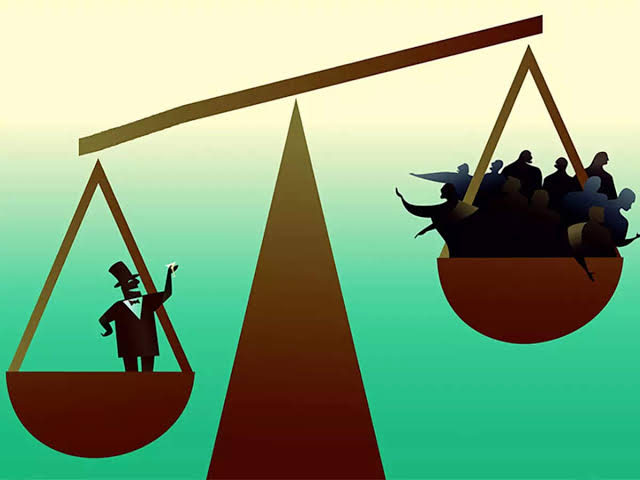Inequality in USA which World Inequality Lab needs to highlight and not harp on India

A recent report from World Inequality Lab titled, ‘Towards Tax Justice and Wealth Redistribution in India’, has reported the economic disparities present in India.
The findings are sobering: nearly 90 per cent of the country’s billionaire wealth is concentrated in the hands of the upper castes, highlighting a deep socio-economic divide.
However this report has not been compiled to help India reduce the Inequality gap but with a purpose to divide India socially and politically.
The analysis in the report mentions that 88.4 per cent of India’s billionaire wealth is controlled by upper castes. In contrast, while Scheduled Castes (SCs) and Scheduled Tribes (STs) together form a significant part of India’s workforce, their representation among enterprise owners remains disproportionately low.
Well this fact is well known and the Government has been trying its best since 1947 to first reduce and next remove poverty. Though in last 10 years there has been a huge progress in this regard. India is determined to eradicate poverty and reduce inequalities. However there US no magic wand and it will take time.
The USA became independent of UK in 1776 and by 2023 had 735 billionaires controlling nearly 3.5 trillion dollars of wealth. However only nine comprising a miniscule 0.01% of this number were from black community which makes up 13 % of Americas population. It means that Indian Backward Casts, SC and STs have comparatively done much better (holding 11.6% of Indian billionaires wealth ).
Six of these black billionaires – Oprah Winfrey, Michael Jordan, Shawn Carter (Jay Z), Tyler Perry, Lebron James and Tiger Woods – are some of the most well-known Black individuals in the world.
Ironically, the most well-known Black billionaires are also the least-wealthy among their Black billionaire peers. The wealthiest African American, Robert Smith, has an estimated net worth of $5 billion in almost twice that of Oprah Winfrey and Jay Z, who are the wealthiest Black entertainers. Smith’s wealth derived from the financial sector. The 25th on Forbes list of billionaires, all whites has a worth of 25 billions !!!
The small contingent of Black American billionaires have a very different industry makeup than the top 500 billionaires listed by the magazine Fortune. A plurality of Fortune’s top 500 billionaires made their money in tech, with about 14% of the list. Another 13% are in the industrial sector and 11% come from finance. Only about 3% are in the entertainment field.
Though the number of US Black billionaires has increased from one to nine in about 20 years, the rise of the Black billionaire has done nothing to bridge wealth inequality. In 2001,when Johnson broke the colour barrier, the median wealth of an African American family was about $15,000. White median wealth was 10 times that, a little over $150,000. By 2019, median white wealth had risen to $160,000 while Black household wealth had shrunk to $9,000. What had been a 10-to-one median wealth advantage for whites leapt to about 18-to-one in less than two decades.
In the most elite economic grouping, the billionaire class, Black billionaires are only O.01% of the billionaires in this country, much smaller than the 13% of the United States population Blacks represent. The racial wealth divide for African Americans is found at every income level: Even the most elite of African Americans, the Black billionaires have little wealth compared to similarly situated white Americans. According to the Forbes 2023 Richest Americans, no African Americans are even in the top 50 wealthiest Americans and several African American billionaires don’t even qualify for the wider Forbes 400 list.
As per the above report, upper castes in India hold nearly 55 per cent of the national wealth. This concentration of wealth also highlights the persistent economic inequalities rooted in India’s caste system.
Nothing surprising because the top 1% of households all whites in the United States held 32.3% of the country’s wealth, while the bottom 50% held just 2.6%. From 1989 to 2019, wealth became increasingly concentrated in the top 10% mostly all whites.
Yes poor in India do not get proper access to essential resources such as education, healthcare, social networks, and credit — all crucial for entrepreneurship and wealth creation.
Historically, Dalits faced prohibitions on land ownership in many regions, severely curtailing their economic progress. Thus SCs and STs are underrepresented among enterprise owners relative to their workforce participation. SCs, comprising 19.3 per cent of the workforce, account for only 11.4 per cent of enterprise owners.
Similarly, STs, making up 10.1 per cent of the workforce, represent just 5.4 per cent of enterprise owners.
In contrast American blacks constitute 13 % of Workforce account only for a easily 3% of enterprise owners. So here too Indian SC and STs score much better.
Now let’s talk about the actual owners of the USA, who got deprived of all their natural wealth….the Red Indians who now constitute just 2.09 % of the American population. They continue to be disenfranchised through further racial wealth divide by competing Blacks, Hispanics and Latinos. Native Americans have a very low share of national wealth compared to others and is only 9% of the national median.
Based on the data cited by Poverty USA, Native Americans have the highest poverty rate among all minority groups. The national poverty rate for Native Americans was 25.4%, while Black or African American poverty rate was 20.8%. Among Hispanics, the national poverty rate was 17.6%. The White population had an 8.1% national poverty rate during the same period.
No doubt in India Wealth inequality is evident across various socio economic groups among all cast groups including Upper castes, though more so in SC and STs. The Other Backward Classes (OBC) community shows a similar trend, with 16.3 per cent of its population in the lowest wealth category and 19.2 per cent in the highest wealth category. However India is trying its best.
The inequality in USA is pathetic and widening among blacks, Hispanics, Latinos and the American( Red ) Indians.




